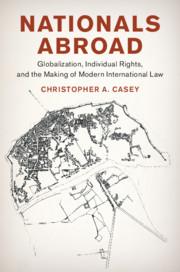Book contents
- Frontmatter
- Dedication
- Contents
- Acknowledgments
- Abbreviations
- Introduction
- Part I Mise-en-scène: The International Legal World, 1850–1914
- 1 The Walls of Gilgamesh
- 2 Making Nations, Breaking Nationality
- Part II Mise-en-scène: The International Legal World, 1919–1939
- Part III Mise-en-scène: The International Legal World, 1945–Present
- Notes
- Index
2 - Making Nations, Breaking Nationality
from Part I - Mise-en-scène: The International Legal World, 1850–1914
Published online by Cambridge University Press: 29 June 2020
- Frontmatter
- Dedication
- Contents
- Acknowledgments
- Abbreviations
- Introduction
- Part I Mise-en-scène: The International Legal World, 1850–1914
- 1 The Walls of Gilgamesh
- 2 Making Nations, Breaking Nationality
- Part II Mise-en-scène: The International Legal World, 1919–1939
- Part III Mise-en-scène: The International Legal World, 1945–Present
- Notes
- Index
Summary
The root of the problem plaguing the international system was the bond of allegiance that tied a person to her state. How did that bond form? What happened to that bond when a person lived far beyond the boundaries of her state? In a world of migration, trade, and international investment how would that bond be defined? Chapter 2 is about that bond of allegiance and how it was reconceptualized in an age of globalization. This chapter has three arguments. First, that the collapse of the mercantilist empires in the late eighteenth and early nineteenth centuries created a crisis of allegiance in which bonds were multiplied and stretched, entangling international politics. Second, that both people and corporations instrumentalized their nationality as a way to obtain a kind of insurance in a volatile world. Third, several states and the international law community recognized this instrumentalization and attempted to curb it only to run into irreconcilable hemispheric disputes over how to define nationality. This irreconcilable hemispheric dispute effectively destroyed nationality as a form of viable protection in a globalized world and would lead to the proliferation of international legal regimes in the twentieth century.
Keywords
- Type
- Chapter
- Information
- Nationals AbroadGlobalization, Individual Rights, and the Making of Modern International Law, pp. 46 - 78Publisher: Cambridge University PressPrint publication year: 2020



